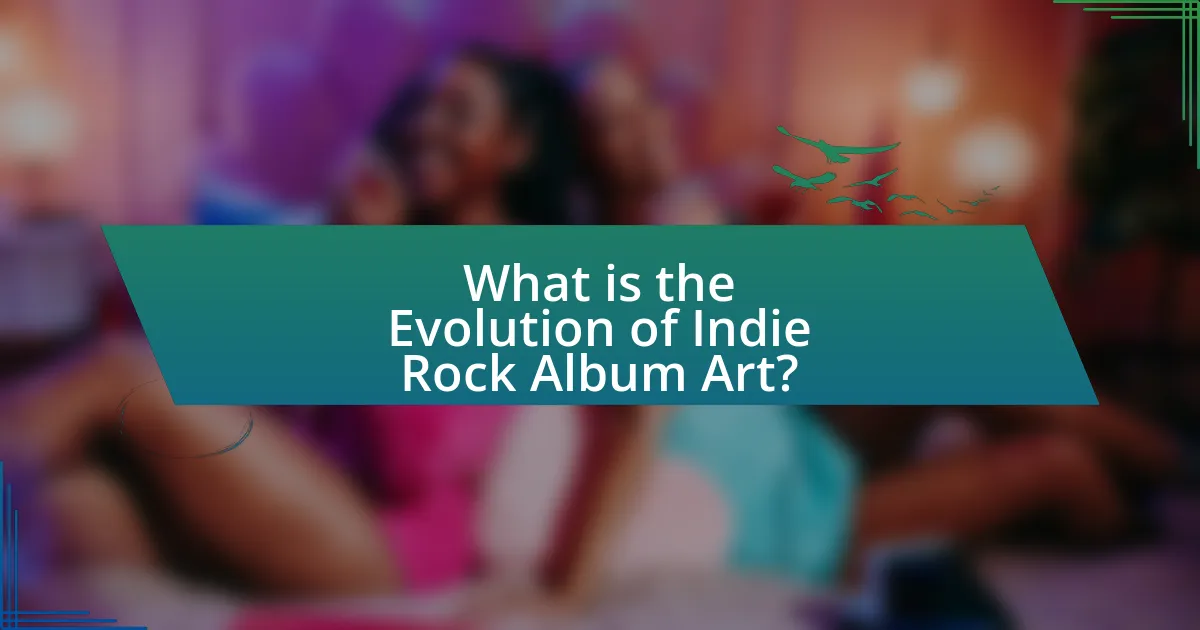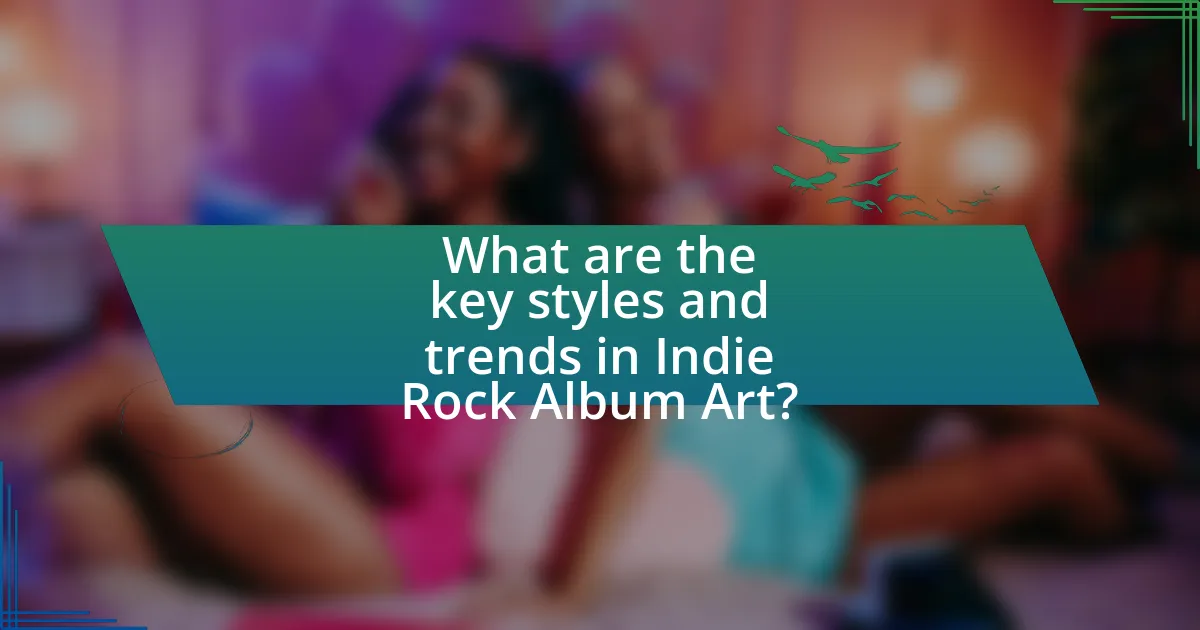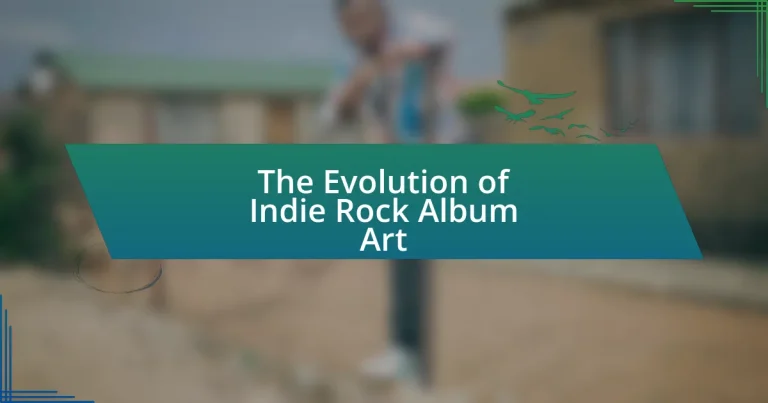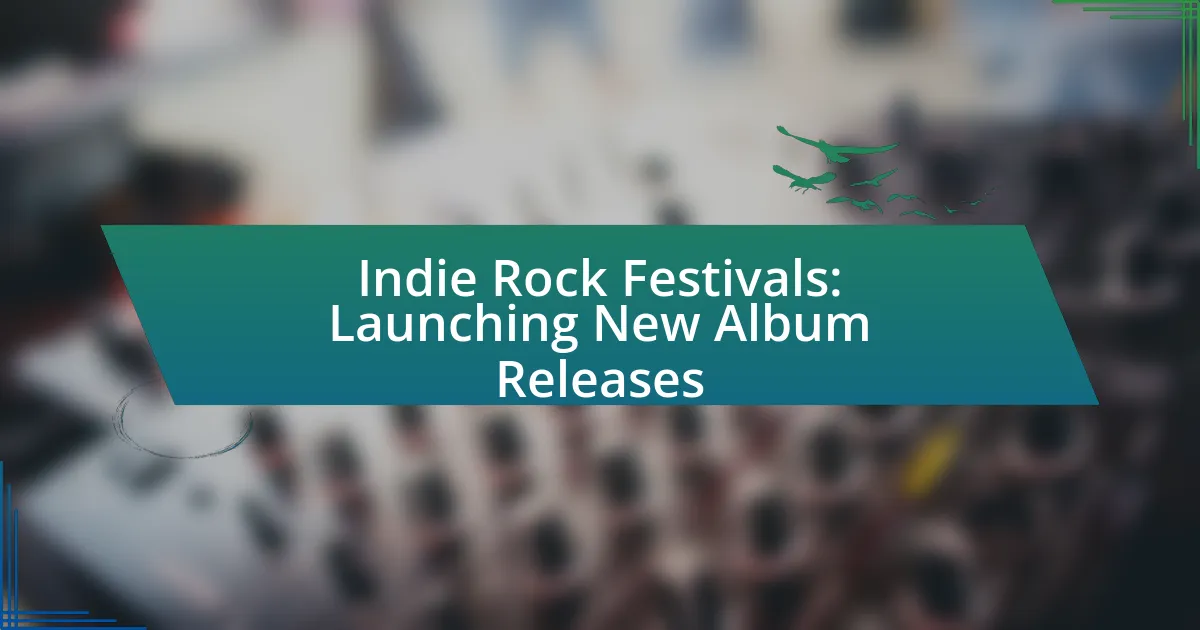The article examines the evolution of indie rock album art, highlighting its transition from DIY aesthetics in the 1980s and 1990s to more polished and diverse visual representations in subsequent decades. It discusses key movements that influenced album design, such as the DIY punk aesthetic, surrealism, and minimalism, as well as the impact of technology on the creation and distribution of album art. The significance of album art in shaping the identity and branding of indie rock artists is emphasized, along with common themes and styles that reflect cultural and societal changes. Additionally, the article explores future trends in album art, including the integration of digital technologies and sustainability practices.

What is the Evolution of Indie Rock Album Art?
The evolution of indie rock album art reflects the genre’s transition from DIY aesthetics to more polished and diverse visual representations. In the 1980s and 1990s, indie rock album covers often featured hand-drawn illustrations, collage techniques, and lo-fi photography, emphasizing a raw and authentic feel that resonated with the underground music scene. Notable examples include the cover of The Pixies’ “Doolittle,” which showcased surreal artwork by Vaughan Oliver, encapsulating the band’s eclectic sound.
As the 2000s approached, the rise of digital technology allowed for more sophisticated design techniques, leading to a blend of traditional and modern styles. Album art began to incorporate vibrant colors, intricate graphics, and conceptual themes, as seen in Arcade Fire’s “Funeral,” which featured a striking, symbolic cover that conveyed the album’s emotional depth.
By the 2010s, indie rock album art further diversified, with artists exploring various mediums, including photography, painting, and digital art. Covers like Tame Impala’s “Currents” exemplified this trend, utilizing abstract designs that mirrored the music’s psychedelic influences. This evolution illustrates how indie rock album art has adapted to cultural shifts and technological advancements while maintaining its core identity of creativity and individuality.
How has indie rock album art changed over the decades?
Indie rock album art has evolved significantly over the decades, reflecting broader cultural and technological changes. In the 1980s, album covers often featured hand-drawn illustrations and collage techniques, emphasizing DIY aesthetics that resonated with the underground music scene. By the 1990s, the rise of digital technology introduced more polished designs, with bands like Radiohead utilizing abstract imagery and conceptual art to convey deeper themes. The 2000s saw a shift towards minimalism and photography, as artists like The Strokes embraced clean lines and striking visuals. In recent years, the integration of social media and digital platforms has led to more experimental and interactive designs, with artists like Billie Eilish using vibrant colors and bold graphics to capture attention in a crowded digital landscape. This progression illustrates how indie rock album art has continuously adapted to reflect artistic trends and technological advancements.
What key movements influenced the design of indie rock album art?
Key movements that influenced the design of indie rock album art include the DIY punk aesthetic, surrealism, and minimalism. The DIY punk aesthetic emerged in the late 1970s, promoting self-produced art and graphics that often featured bold colors and hand-drawn elements, which became a staple in indie rock visuals. Surrealism, with its emphasis on dream-like imagery and unconventional compositions, inspired many indie artists to explore abstract and imaginative designs. Minimalism also played a significant role, encouraging simplicity and the use of negative space, which can be seen in various indie album covers that prioritize clean lines and understated visuals. These movements collectively shaped the distinctive and diverse visual language of indie rock album art.
How did technology impact the creation of album art in indie rock?
Technology significantly transformed the creation of album art in indie rock by enabling artists to utilize digital tools for design and distribution. The advent of graphic design software, such as Adobe Photoshop and Illustrator, allowed indie musicians to create visually compelling artwork without the need for professional graphic designers, thus reducing costs and increasing creative control. Additionally, the rise of online platforms and social media facilitated the sharing and promotion of album art, allowing artists to reach wider audiences and engage with fans directly. This shift not only democratized the design process but also encouraged innovative and diverse artistic expressions within the indie rock genre.
Why is album art significant in the indie rock genre?
Album art is significant in the indie rock genre because it serves as a visual representation of the music’s identity and ethos. In indie rock, where artistic expression and individuality are paramount, album covers often reflect the band’s unique style, themes, and cultural influences. For instance, iconic album covers like “In the Aeroplane Over the Sea” by Neutral Milk Hotel and “Funeral” by Arcade Fire have become emblematic of the genre, enhancing the listener’s connection to the music. Additionally, the DIY ethos prevalent in indie rock encourages artists to create distinctive and often unconventional artwork, further solidifying the importance of album art as a medium for storytelling and artistic expression.
What role does album art play in the branding of indie rock artists?
Album art plays a crucial role in the branding of indie rock artists by visually representing their identity and musical style. This visual representation helps to establish a unique aesthetic that resonates with their target audience, differentiating them in a crowded market. For instance, iconic album covers like The Velvet Underground & Nico’s banana or Radiohead’s OK Computer have become synonymous with the artists’ brands, influencing public perception and engagement. Additionally, studies show that compelling album art can increase sales and streaming numbers, as it captures attention and encourages exploration of the music. Thus, effective album art not only enhances brand recognition but also contributes to the overall success of indie rock artists.
How does album art contribute to the listener’s experience?
Album art significantly enhances the listener’s experience by visually representing the music’s themes and emotions. This visual representation can evoke feelings and set the mood before the listener even plays the album, creating an anticipatory connection. For instance, iconic album covers like Pink Floyd’s “The Dark Side of the Moon” not only reflect the music’s complexity but also become a cultural symbol, influencing listener perceptions and engagement. Research indicates that visual elements can enhance memory retention and emotional responses to music, demonstrating that well-designed album art can deepen the overall impact of the listening experience.

What are the key styles and trends in Indie Rock Album Art?
Key styles and trends in Indie Rock album art include minimalism, hand-drawn illustrations, and vintage aesthetics. Minimalism often features simple designs with limited color palettes, emphasizing the music’s emotional depth. Hand-drawn illustrations reflect a personal touch, showcasing the individuality of the artists and their creative processes. Vintage aesthetics draw inspiration from past decades, incorporating retro typography and imagery that evoke nostalgia. These trends are evident in notable album covers, such as “In the Aeroplane Over the Sea” by Neutral Milk Hotel, which uses a collage style, and “The Suburbs” by Arcade Fire, which features a nostalgic, suburban landscape. The evolution of these styles highlights the genre’s emphasis on artistic expression and connection to cultural movements.
What are the most notable artistic styles used in indie rock album art?
The most notable artistic styles used in indie rock album art include minimalism, collage, and surrealism. Minimalism often features simple designs and limited color palettes, emphasizing the music’s emotional depth, as seen in albums like “For Emma, Forever Ago” by Bon Iver. Collage incorporates various materials and images, creating a layered effect that reflects the eclectic nature of indie rock, exemplified by the artwork of “The Suburbs” by Arcade Fire. Surrealism introduces dreamlike and fantastical elements, challenging perceptions and inviting interpretation, as demonstrated in the cover of “In the Aeroplane Over the Sea” by Neutral Milk Hotel. These styles collectively contribute to the unique visual identity of indie rock, enhancing the listener’s experience.
How do color schemes and typography influence indie rock album art?
Color schemes and typography significantly influence indie rock album art by shaping the visual identity and emotional resonance of the music. The choice of colors can evoke specific feelings; for instance, vibrant colors often convey energy and excitement, while muted tones may suggest introspection or melancholy. Typography also plays a crucial role, as unique fonts can reflect the band’s personality and genre, enhancing the overall aesthetic. Research indicates that visual elements like color and typeface can impact consumer perception and engagement, making them essential tools for artists to communicate their artistic vision effectively.
What are some iconic examples of indie rock album art styles?
Iconic examples of indie rock album art styles include the minimalist designs of The White Stripes’ “White Blood Cells,” characterized by its stark red and white color scheme, and the collage aesthetic of Neutral Milk Hotel’s “In the Aeroplane Over the Sea,” which features hand-drawn illustrations and a whimsical, nostalgic feel. Additionally, the vibrant and surreal artwork of Animal Collective’s “Merriweather Post Pavilion” showcases a psychedelic approach, while the lo-fi, DIY style of The Mountain Goats’ “The Sunset Tree” reflects a personal and raw artistic expression. These styles are significant as they often reflect the ethos of the indie rock movement, emphasizing creativity, individuality, and a departure from mainstream commercialism.
How do cultural and social movements reflect in indie rock album art?
Cultural and social movements significantly influence indie rock album art by serving as a visual representation of the themes and values associated with those movements. For instance, the feminist movement has inspired album covers that challenge gender norms and promote female empowerment, as seen in the artwork of bands like Sleater-Kinney, which often features bold imagery and messages that resonate with feminist ideals. Additionally, the LGBTQ+ rights movement has led to vibrant and inclusive designs, such as those by artists like Frank Ocean, whose album covers often reflect themes of identity and acceptance. Historical context further supports this connection; during the 1960s and 1970s, the counterculture movement influenced psychedelic art styles in album covers, exemplified by The Beatles’ “Sgt. Pepper’s Lonely Hearts Club Band,” which visually encapsulated the era’s spirit of rebellion and exploration. Thus, indie rock album art serves as a canvas for expressing the cultural and social dynamics of its time, making it a vital aspect of the genre’s evolution.
What themes are commonly represented in indie rock album art?
Common themes represented in indie rock album art include nostalgia, surrealism, and personal introspection. Nostalgia often manifests through vintage aesthetics or imagery that evokes past eras, reflecting the genre’s roots and influences. Surrealism is frequently employed to create dreamlike visuals that challenge reality, aligning with the experimental nature of indie rock. Personal introspection is depicted through intimate portraits or abstract designs that convey emotional depth, resonating with the lyrical content of the music. These themes are prevalent as they resonate with the indie rock audience’s desire for authenticity and emotional connection.
How have societal changes influenced the visual aesthetics of indie rock album art?
Societal changes have significantly influenced the visual aesthetics of indie rock album art by reflecting cultural movements, technological advancements, and shifts in consumer behavior. For instance, the rise of digital technology and social media has led to a more DIY approach in album art, allowing artists to experiment with graphic design and photography without the constraints of traditional publishing. This shift is evident in the use of vibrant colors, bold typography, and eclectic imagery that resonate with contemporary themes such as identity, mental health, and social justice. Additionally, the influence of movements like feminism and environmentalism has prompted artists to incorporate messages and visuals that challenge societal norms, as seen in album covers that feature feminist iconography or eco-conscious designs. These changes illustrate how indie rock album art serves as a visual commentary on the evolving cultural landscape, making it a dynamic reflection of societal values and trends.

What are the future trends in Indie Rock Album Art?
Future trends in Indie Rock album art will increasingly focus on digital and interactive designs, reflecting the growing influence of technology in music consumption. As streaming platforms dominate, artists are likely to create album art that is not only visually striking but also incorporates augmented reality (AR) elements, allowing fans to engage with the artwork through their devices. This trend is supported by the rise of apps that enhance album experiences, such as those that provide behind-the-scenes content or interactive storytelling. Additionally, sustainability will play a significant role, with artists opting for eco-friendly materials and practices in physical releases, aligning with broader environmental concerns among consumers. The integration of social media aesthetics will also shape album art, as artists aim to create shareable visuals that resonate on platforms like Instagram and TikTok, where visual impact is crucial for audience engagement.
How is digital art shaping the future of indie rock album art?
Digital art is revolutionizing indie rock album art by enabling artists to create visually striking and innovative designs that reflect contemporary themes and aesthetics. The accessibility of digital tools allows independent musicians to experiment with styles and techniques that were previously limited by traditional media, fostering a diverse range of artistic expressions. For instance, platforms like Adobe Creative Suite and Procreate have democratized design, allowing artists to produce high-quality artwork without the need for expensive materials or professional training. This shift not only enhances the visual appeal of album covers but also aligns with the digital consumption habits of modern audiences, as visually engaging content is more likely to attract attention on streaming platforms and social media.
What emerging technologies are influencing album art design?
Emerging technologies influencing album art design include augmented reality (AR), artificial intelligence (AI), and 3D printing. AR allows artists to create interactive album covers that engage listeners through mobile devices, enhancing the visual experience. AI tools can generate unique artwork based on algorithms, enabling artists to explore new creative avenues and streamline the design process. Additionally, 3D printing technology enables the production of physical album art with intricate designs, offering a tactile experience that digital formats cannot replicate. These technologies are reshaping how album art is conceptualized and experienced in the music industry.
How are indie artists adapting to changes in consumer behavior regarding album art?
Indie artists are adapting to changes in consumer behavior regarding album art by increasingly utilizing digital platforms and social media to create interactive and visually engaging content. This shift is driven by the decline in physical album sales and the rise of streaming services, which prioritize digital visuals over traditional packaging. For instance, artists are now designing album art that is optimized for social media sharing, often incorporating animated graphics or augmented reality features to enhance viewer engagement. According to a 2022 survey by the Music Industry Association, 70% of consumers reported that they discover new music primarily through social media, highlighting the importance of visually appealing album art in attracting listeners.
What practical tips can artists use to create impactful indie rock album art?
Artists can create impactful indie rock album art by focusing on originality, emotional resonance, and visual storytelling. Originality is crucial; unique designs help an album stand out in a crowded market, as evidenced by the iconic cover of The Beatles’ “Sgt. Pepper’s Lonely Hearts Club Band,” which remains influential due to its distinctive style. Emotional resonance connects the artwork to the music, allowing listeners to feel the album’s themes visually; for instance, the stark imagery of Radiohead’s “OK Computer” reflects the album’s themes of alienation and technology. Visual storytelling enhances the narrative of the music, as seen in the cover of Arcade Fire’s “The Suburbs,” which visually represents the themes of nostalgia and suburban life. By combining these elements, artists can create album art that not only captures attention but also deepens the listener’s connection to the music.
How can artists effectively communicate their music’s message through album art?
Artists can effectively communicate their music’s message through album art by using visual elements that reflect the themes, emotions, and narratives present in their music. For instance, color schemes, imagery, and typography can evoke specific feelings that align with the sound and lyrics of the album. Research indicates that visual aesthetics significantly influence listeners’ perceptions and interpretations of music; a study published in the Journal of Experimental Psychology found that album covers can shape listener expectations and emotional responses. By thoughtfully designing album art that resonates with the music’s core message, artists can create a cohesive experience that enhances audience engagement and understanding.
What resources are available for indie artists to design their album art?
Indie artists can utilize various resources to design their album art, including graphic design software, online design platforms, and freelance designers. Software such as Adobe Photoshop and Illustrator offers advanced tools for creating custom artwork, while platforms like Canva and Visme provide user-friendly templates and design elements tailored for non-designers. Additionally, websites like Fiverr and Upwork connect indie artists with freelance graphic designers who can create unique album art based on the artist’s vision. These resources empower indie artists to produce professional-quality album art that reflects their musical identity.



